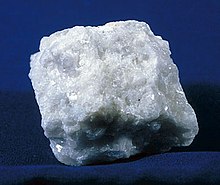Marble
![]()
The title of this article is ambiguous. For other meanings, see Marble (disambiguation).
Marble (via Latin marmor from Ancient Greek μάρμαρος mármaros "[shiny] boulder, stone; marble", this derived from μαρμαίρειν marmaírein "to shimmer, flicker") refers to carbonate rocks of various compositions, consisting mainly of the minerals calcite and dolomite, and due to their material properties are used especially for sophisticated architecture or for the production of sculptures.
There are different word meanings for marble:
- Petrographically, it is a metamorphic rock formed by transformation (metamorphism) of limestone and other carbonate-rich rocks, in the earth's interior by heat and pressure.
- Besides the petrographic term, cultural and economic marble terms can be distinguished.
A number of significant buildings and works of art are made of marble. Marbles are used for floor and stair coverings, table tops, wall tiles, washbasins and facade panels. The extraction of marble, which has been going on for thousands of years, is still a laborious process today.

Laocoongroup in marble in the Vatican Museums
Origin
Marble is formed by metamorphic transformation of limestones, dolomites and other carbonate-rich rocks under the influence of high pressure and high temperature as a result of high sedimentary loading and/or tectonic subsidence (regional metamorphism) or by heating in contact with molten rock (contact metamorphism). If dolomites have been transformed, they are referred to as dolomite marble.
During contact metamorphism, granitic or other magmas intrude into the Earth's upper crust. If they do not reach the Earth's surface, they remain in the crust, cooling in magma chambers over millennia and solidifying into granite or igneous rocks of similar composition. During this phase of cooling, carbonate-rich rocks in the vicinity of the granite pluton may transform into marble. During contact metamorphism, there is a pressure of up to 10 kilobars and a temperature of over 400 °C.
Regional metamorphism involves the transformation of large quantities of rock under pressure and heat without magma contact. These processes take place very slowly. In the process, for example, marbles with directional structure (fissure-trained slabs extractable) can be formed. The preferred direction of cleavage is usually orthogonal to the direction of the former main stress. Since marbles deform ductilely above a certain pressure and temperature level, they can show folds and flow structures, which are visible as marbling in case of an inhomogeneous distribution of the secondary aggregate constituents (e.g. in the Saillon marble of Saillon, Switzerland). In geology, ductile means that rocks, especially of the lower continental crust, deform plastically rather than brittly under tectonic stress (heat and pressure).
Features and mineralogy
Marbles are usually medium to large crystalline, the individual calcite crystals vary little in size and can often be distinguished with the naked eye. However, extremely fine crystalline marbles also occur, such as the Statuario variety from Carrara, which is highly sought after by sculptors. The characteristic of crystallinity also applies to marbles whose parent rocks had a sedimentary grain structure, such as the majority of meta-limestones and meta-marlstones (a meta-rock is also, for example, a sandstone formed from a sandstone, etc.). Due to the crystalline structure, the pore space of marble is small, which leads to high frost resistance of many types of marble, but it cannot be generalized for all types. A typical characteristic of marble is the absence of fossils. Marbles can also be recognized visually by the fact that individual calcite crystals glitter in the cleavage surface, depending on the direction of the incidence of light (see illustration).
The admixture of substances in the original stone leads to the typical decoration of many marbles, the so-called marbling. Marble occurs in different colours - from black-striped to yellow, green, pink and white marble. Red to reddish marbles are coloured by haematite, yellow to brown ones by limonite, slightly bluish and grey-blue ones by graphite, carbonaceous substances or bitumen and green marbles by chlorite or serpentine minerals. Multi-coloured marbles contain different mineral admixtures and/or different crystal formations. Uniformly black coloured marbles do not exist.
White marble, such as that found near Carrara in the Apuan mountain valleys in Italy and in the Kras Valley in Austria, is in great demand. In Germany there are few marble deposits that are economically viable for natural stone, for example the Wunsiedl marble in the Fichtelgebirge mountains. In the Erzgebirge, calcite and dolomite marble is mined near Hammerunterwiesenthal, which is mainly processed into crushed stone and very fine rock flour and is mainly used as an aggregate for industry. Due to the high density of fissures and faults, it is not possible to extract sufficiently large blocks suitable for economic use in natural stone production. The Crottendorf marble had gained a temporary importance as sculpture material.
Typical dolomite marbles are those of the Rauris Valley in Austria and the Thassos marble from the Greek island of the same name. A speciality is the so-called Cipollino (Italian for "onion"), a marble whose decoration is layered like an onion.
The white marbles are translucent. It shimmers through a marble variety from Paros up to a stone thickness of about 3.5 centimeters and through those from Carrara up to about 1.5 centimeters. The so-called translucence depends on the crystal structure and the pore radius distribution. The denser a marble is, the more translucent it is. A typical example is the marble quarried from Turkey near Afyon.

marble, handpiece
Search within the encyclopedia